Facts About Nile crocodile
The Nile crocodile (Crocodylus niloticus) is one of Africa’s most formidable predators, inhabiting freshwater environments across 26 countries on the continent. Classified as "Least Concern" by the IUCN since 1996, these crocodiles thrive in sub-Saharan Africa, particularly in the central, eastern, and southern regions. They are typically found in lakes, rivers, and swamps, and occasionally in brackish lakes and deltas, though they rarely venture into saltwater.
Adult male Nile crocodiles generally measure between 3.5 to 5 meters in length and weigh between 225 to 750 kg. However, some can grow even larger, exceeding 6 meters and weighing up to 1,089 kg. These reptiles are the largest freshwater predators in Africa and the second-largest living reptiles after the saltwater crocodile. Females are generally about 30% smaller than males but share the same thick, scaly, heavily armored skin.
As apex predators, Nile crocodiles have a varied diet that includes fish, reptiles, birds, and mammals. They are known for their ambush hunting style, waiting patiently for the perfect moment to strike with a bite so powerful it’s nearly impossible to escape. Interestingly, they also display social behaviors, such as sharing basking spots and food sources, and maintaining a strict size-based hierarchy. Females are protective of their eggs and young for some time, though the hatchlings must eventually fend for themselves. Despite their conservation status, Nile crocodiles are responsible for hundreds of human fatalities each year.
The name "Crocodylus niloticus" comes from Greek, referring to their rough skin and association with the Nile River. They are known by various names across Africa, including African, Ethiopian, common, or black crocodile. While no subspecies are officially recognized, regional differences in appearance and size have led to some proposals. Recent research suggests that the West African crocodile (Crocodylus suchus) is a distinct species closely related to East Asian crocodiles.
Nile crocodiles have a dark bronze color with faded blackish spots and stripes on their backs, and an off-yellow underbelly. Their green eyes and coloration provide effective camouflage in their natural habitats. Morphologically, they share typical crocodilian features: a quadrupedal stance, a powerful tail, scaly hide, elongated jaws, and a four-chambered heart for efficient blood oxygenation. They have a nictitating membrane to protect their eyes and can hold their breath for up to two hours, thanks to high lactic acid levels in their blood.
Their skulls house 64 to 68 sharp teeth, which can be replaced throughout their lives. Hatchlings have an egg tooth to help them break out of their shells. With a long snout and a bite force of 22 kN (5,000 lbf), their jaws are incredibly powerful, though the muscles to open them are weak enough for a person to hold shut. Males are larger than females, especially after reaching sexual maturity.
Nile crocodiles are widely distributed across Africa, with isolated populations in Madagascar. They inhabit various aquatic environments and can tolerate saline waters. Invasive populations have even been found in South Florida, although they are not known to be reproducing in the wild there.
Behaviorally, these crocodiles spend a lot of time basking and are very aware of their surroundings. They can be aggressive if threatened and have a rich vocal range and good hearing. On land and in water, they can move quickly and swallow stones (gastroliths) to aid in digestion. The myth of their relationship with birds like the Egyptian plover lacks substantial evidence.
As apex predators, Nile crocodiles hunt both in water and on land, using ambush tactics. They can go long periods without eating due to their ectothermic metabolism. Their diet varies with size; young crocodiles eat insects and other invertebrates, while adults take larger prey, including fish, reptiles, birds, and mammals. They are known to scavenge and steal kills from other predators, and their hunting techniques include herding fish and cooperating to block migrating fish.
Nile crocodiles reach sexual maturity between 12 to 16 years of age. Males mature at about 3.3 meters in length, while females mature between 2.2 to 3 meters. They lay eggs in nests dug in sandy or earthy banks, with clutch sizes varying by female size. The temperature of the nest determines the sex of the hatchlings, and the mother protects them for up to two years. However, only about 1% of young crocodiles survive to adulthood, primarily due to predation.
Conservation efforts have helped Nile crocodile populations recover from severe declines caused by hunting for leather and meat. Today, they are farmed for their meat and leather in some parts of Africa, with sustainable-yield programs in place. However, threats like habitat loss, pollution, and human activities continue to impact their populations.
Nile crocodiles are infamous for their attacks on humans, causing hundreds of deaths annually. They are more likely to attack humans due to their proximity to human populations and large size. Most attacks occur when humans are near water, and incautious behavior increases the risk. Despite their fearsome reputation, with proper precautions, interactions between humans and Nile crocodiles can be managed.

 Tanzania
Tanzania